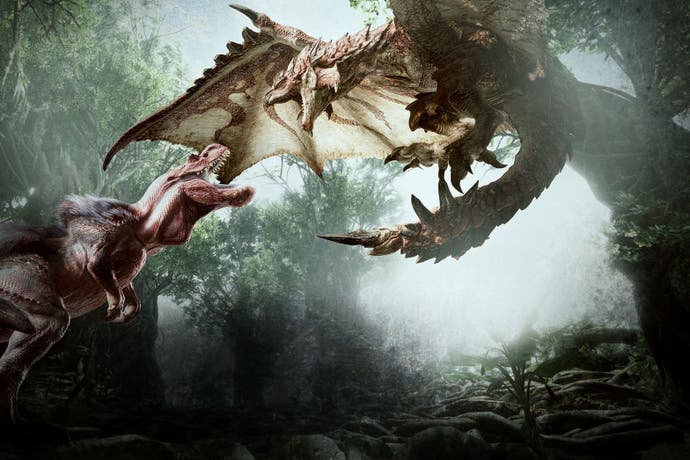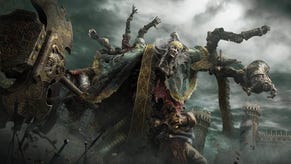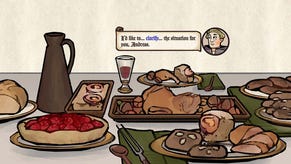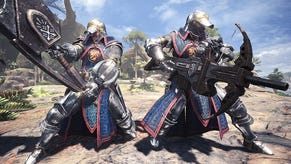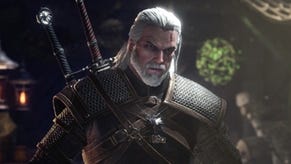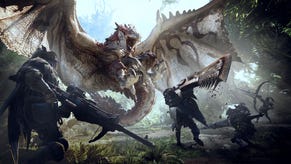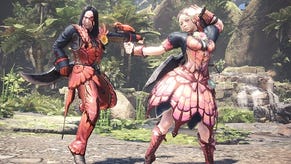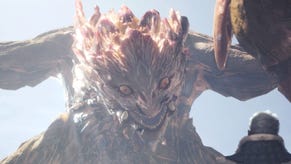Why does smashing a monster in the face in Monster Hunter World feel so good?
Making a monster - behind the scenes of Capcom's epic.
Do you know what makes Monster Hunter: World's beasts so convincing? Motion capture. That's right, some of World's creature animations began life as a person in a moleskin suit flailing around the studio, rolling on the floor, flapping their arms like wings, and scurrying about on all-fours. Yes, we humans were the monsters all along. Boom! Plot twist.
Capcom used motion capture to achieve a very specific goal: creating a baseline for animations that require a creature's weight to be thrown around its center of balance, an extremely difficult effect to do by hand. Of course, this doesn't work when you want to imitate what happens when someone pelts a dinosaur in the face with an eight-foot sword (Disclaimer: no mocap actors were harmed during the making of Monster Hunter: World).
"As an action game, monster feedback animations are really important," art director Kaname Fujioka explains. "You have to account for which part of the monster the player attacks, from what angle, how much damage they've imparted, and figure out how to make the animation work as part of the feedback you give the player while making it satisfying."
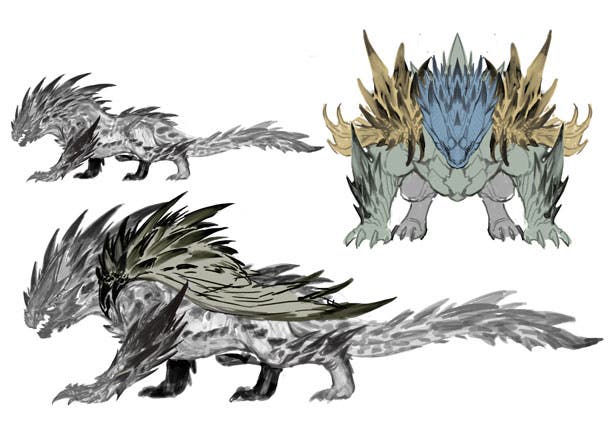
Other variables, such as weapon weight and hit strength, also play a role. All these factors are calculated together, then the animation is stretched at the point of impact - a technique Capcom developed for Street Fighter - to overemphasise the result for a fleeting second, tricking the eye. Add exaggerated audio effects for slashes or blunt force trauma, and it feels like Superman hitting a Tyrannosaurus rex around the head with a bus.

"While using huge weapons [are] one of the concepts of Monster Hunter, it's also really important as an action game for the weapons to feel responsive," Fujioka adds. "You want them to feel weighty but also as if you can swing them around easily. We analyse which parts of animations are key to a weighty feeling and which are not, and design them to seamlessly flow together, even working on the frame-by-frame level. You could call this the artisanship of our team members who have worked on action games for many years."
The work was substantial. Not only are there 31 large monsters and 17 small monsters to hit, but - as is tradition for the series - there are 14 weapons to hit them with. Every single one of them needed to be as satisfying to wield as the next.
"I really went back to the basic concept for each weapon and tried to reinforce it, while making adjustments to the action to take into account new gameplay features like the seamless maps and new monster behaviours," game director Yuya Tokuda explains. "For each weapon I thought carefully about whether the existing and new actions each weapon had really fit with its concept, and whether a given weapon was detracting from the uniqueness of another."
One weapon that saw the most change in World was the Heavy Bowgun. All the game's projectile weapons had to be reworked to function the same as a gun does in any standard third-person shooter, so these firearms were heavily revised and tweaked until they were as satisfying to use as the melee weapons. The various ammo types, each one changing how the Heavy Bowgun fires, are what makes the weapon retain its Monster Hunter flavour. "It was a process of trial and error to get the weapon to where it is in the final game, but it was a lot of fun," Tokuda says.
Because there's so much choice, Capcom had to be very careful about easing players in - particularly as World was designed to work as an entry point for people unfamiliar with the series. That's why everyone's first proper hunt in World is the soft-bellied Great Jagras.
 7 Things That Scare You About Monster Hunter World But Shouldn't - New Monster Hunter World Gameplay
7 Things That Scare You About Monster Hunter World But Shouldn't - New Monster Hunter World Gameplay
"[It is] a monster you practise on to get used to using weapons in the game, so we designed its body to be easy to hit with any weapon," Tokuda explains. "Pukei-Pukei teaches players about the various things they can use around the stage by having it grab them in its mouth and use them to attack players. Barroth teaches them about dodging and guarding by charging directly at them."
By the time players get to Nergigante, Capcom hopes that they've figured out how to craft the right equipment for the job, have learned about monster weaknesses, elemental affinities, and are equipped with the tools they need to take it down. Essentially, this is where the real Monster Hunter: World begins, where the training wheels come off, and where some players will feel like they're the ones being wholloped by a bus.
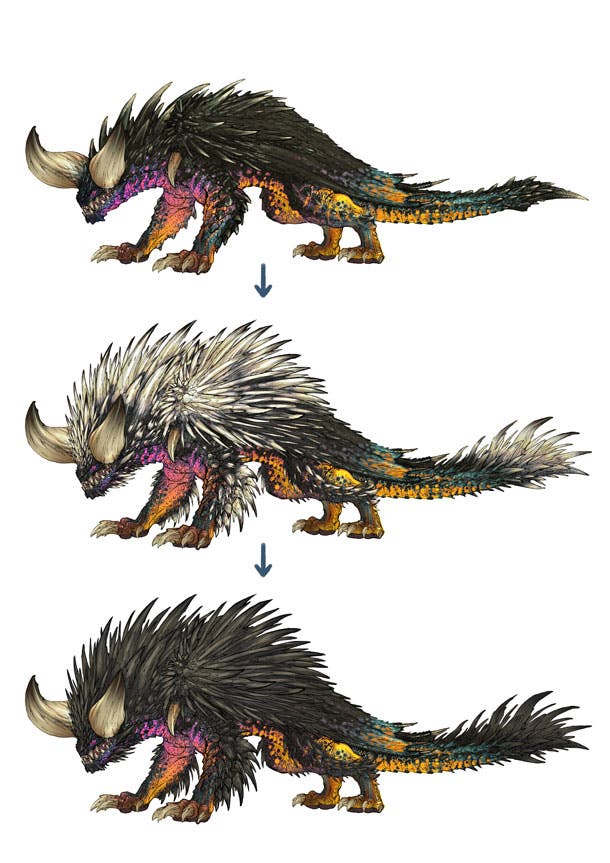
While some people will bounce off at this point, the difficulty spike is absolutely essential. This is a game where you are doing the same thing over and over, so there needs to be a challenge. This ramping difficulty works in tandem with one other ingredient to keep things fresh: random chance. No two hunts ever feel like they play out the same way, whether that is because you are with a different mix of other players wielding different weapons, or because your clean fight gets rudely interrupted by World's ecosystem.
"The Monster Hunter series has always strove to depict monsters as part of an ecosystem by showing them hunting prey, getting thirsty and drinking water, and so on," Tokuda explains. "But in Monster Hunter: World, it's the first time we've synced up the behaviour of the herbivorous creatures across all players, so it lets us show even more realistic predator and prey behaviour: monsters basking in the sun or marking their territory, excretions, fighting with other monsters, and so on. All these behaviours and desire parameters are controlled by the AI and bring out the feeling of being a real, living creature.
"I created an ecosystem pyramid starting from the 'producers' at the bottom and working up to the predators. The producers are the fodder at the bottom of the pyramid which is eaten by herbivorous monsters and are designed to fit realistically into the design of each map - for example, the coral eggs in the Coral Highlands."
To create an in-universe justification for these eggs being scattered around the Coral Highlands, the development team created wind currents that breeze around the map. This then fed into the gameplay itself, spawning little air pockets that players can glide across to climb higher through the environment.
"We added as many gameplay elements that flow from the map design like this as possible, like soft coral areas where monsters can be knocked over and as they can't get their footing easily you can open up an attack window," Tokuda continues. "By deciding the characteristics of the fodder and the special characteristics of each environment - humid forests, open wastelands, swamps - and the requirements of the level design in terms of user experience - will there be lots of easy to understand charging attacks, or tricky ones using trees, or lightning attacks etc? - we can form a basis for creating monsters with appropriate characteristics for that environment."
Without this variety, no matter how satisfying it is to whack a monster really hard in the head, World would lose its spark after a few hours. Because of the way it is designed - with everything feeding into something else, with hidden depth and details hidden in plain sight all around you - you never feel like you are having the same fight. There are just too many factors at play, too many cogs spinning. It creates the perception that anything can happen - and it's that promise that keeps your eyes glued to the screen and your sword embedded in some terrible beast's hide.
